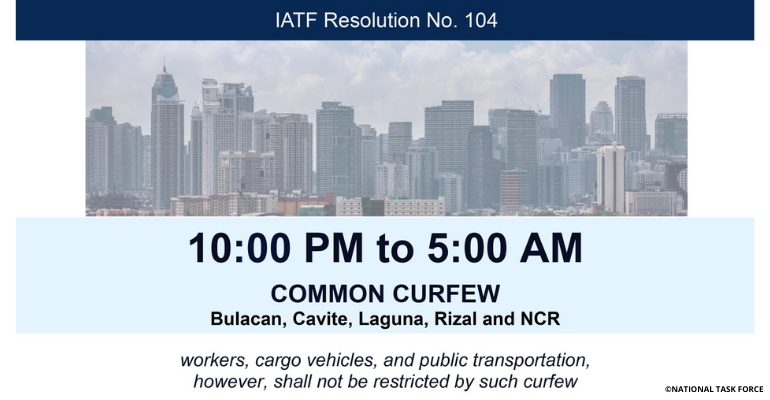Due to the alarming surge of COVID-19 cases, Malacañang announced the reimposing of GCQ on Sunday, March 21.
The government is reimposing movement restrictions in certain economic and establishment activities in Metro Manila and other general community quarantine areas starting March 22 to April 4, 2021.
In a virtual presser, Presidential Spokesperson Harry Roque said President Rodrigo Duterte approved additional restrictions through Inter-Agency Task Force Resolution No. 104.
Starting Monday, Roque said Bulacan, Cavite, Laguna, and Rizal will be joining Metro Manila under the GCQ classification.
Roque dismissed as “fake news” that there would be a hard lockdown in Metro Manila and neighboring provinces.
“Wala po tayong lockdown. Fake news po yung sinasabi na magkakaroon tayo ng circuit breaker. Hindi po totoo ‘yan. Ang Metro Manila po ay manananitili under GCQ kasama po ang mga probinsya ng Bulacan, Cavite, Laguna, at Rizal (We won’t have a lockdown. Reports about a circuit breaker lockdown are fake news. That’s not true. Metro Manila will remain under GCQ along with the provinces of Bulacan, Cavite, Laguna, and Rizal),” he said.
Under IATF Resolution No. 104, he said only essential travel into and out of Metro Manila, Bulacan, Cavite, Laguna, Rizal will be allowed.
Roque described this as a “travel bubble” where residents will only be allowed to travel within their respective provinces.
“Bawal po ang pagbibiyahe papunta sa Metro Manila at mga probinsya ng Bulacan, Cavite, Laguna, Rizal at bawal din po lumabas ng Metro Manila at ng Bulacan, Cavite, Laguna, Rizal. Magkakaroon po tayo ng parang bubble dito sa NCR at probinsya ng Bulacan, Cavite, Laguna, Rizal (Traveling into and out of Metro Manila and the provinces of Bulacan, Cavite, Laguna, Rizal will be prohibited. We will have a sort of bubble in NCR, and the provinces of Bulacan, Cavite, Laguna, Rizal,” he said.
Travel of authorized persons outside their residences (APORs) such as essential workers, health and emergency frontline services personnel; government officials and government frontline personnel; duly-authorized humanitarian assistance actors; persons traveling for medical or humanitarian reasons; persons going to the airport for travel abroad, returning overseas Filipinos and overseas Filipino workers (OFWs) will be unimpeded for as long as they show their respective work identification cards.
Individuals crossing zones for work or business and going back home will also be allowed to travel to and from the said areas.
“Kung kayo ay uuwi, essential travel po ‘yun. Kailangan lang magpakita ng ID kung saan ka talaga nakatira (If you’re going back home that’s essential travel. All you need to do is show your ID to prove that you live there),” he said.
He expressed hope the public would understand that additional restrictions in the said areas were being done “for the common good.”
Public transpo retains capacity
Despite these additional restrictions, Roque said public transportation will retain current capacity subject to minimum health standards.
“Wala pong pagbabawas sa public transportation (There will be no limit to public transportation),” he said.
Biking and walking, he said, will also be encouraged.
Scheduled flights will not be canceled, however, he said non-essential travel including that for tourism, will be prohibited.
Public gatherings limited
All public gatherings, including religious gatherings, will be prohibited but weddings, baptism, and funerals will be allowed but must observe a 10-person venue capacity.
Current operational capacities of essential and non-essential services and industries will remain.
However, face-to-face meetings, group meals in workplaces will be prohibited. Instead, work-from-home and virtual meetings are encouraged.
Roque said the IATF resolution also enjoins the private sector to adopt similar alternative working arrangements as those in place in the executive branch of government such as operating on a 30 to 50 capacity.
Only outdoor dining allowed
As for dining, Roque said only outdoor dining will be allowed in areas under GCQ while indoor dining will be strictly prohibited.
“Pagdating po sa mga restaurants, ang papayagan lang po yung mga outdoor dining (When it comes to restaurants, we will only allow those with outdoor dining),” he said.
Outdoor dining must observe a maximum of 50 percent venue capacity.
Take out and delivery is encouraged, he added.
Wear masks at home
Although the economy will stay open, Roque said the IATF resolution will require persons below 18-years-old and above 65-years-old, those with comorbidities, and pregnant women to remain inside their residences at all times.
The IATF resolution also advises wearing a face mask at home, especially when living with the elderly and vulnerable.
Moreover, accepting visitors outside the immediate family or household is strongly discouraged.
Operations for the following limited social events at accredited tourism establishments and limited tourism attractions will be temporarily suspended, except for open-air tourism attractions:
- Driving schools
- Traditional cinemas
- Video and interactive game arcades
- Libraries
- Archives
- Museums
- Cultural centers
Source: Philippine News Agency
Also Read: Gov’t warns public vs. unauthorized COVID-19 vax selling

Leave a Reply